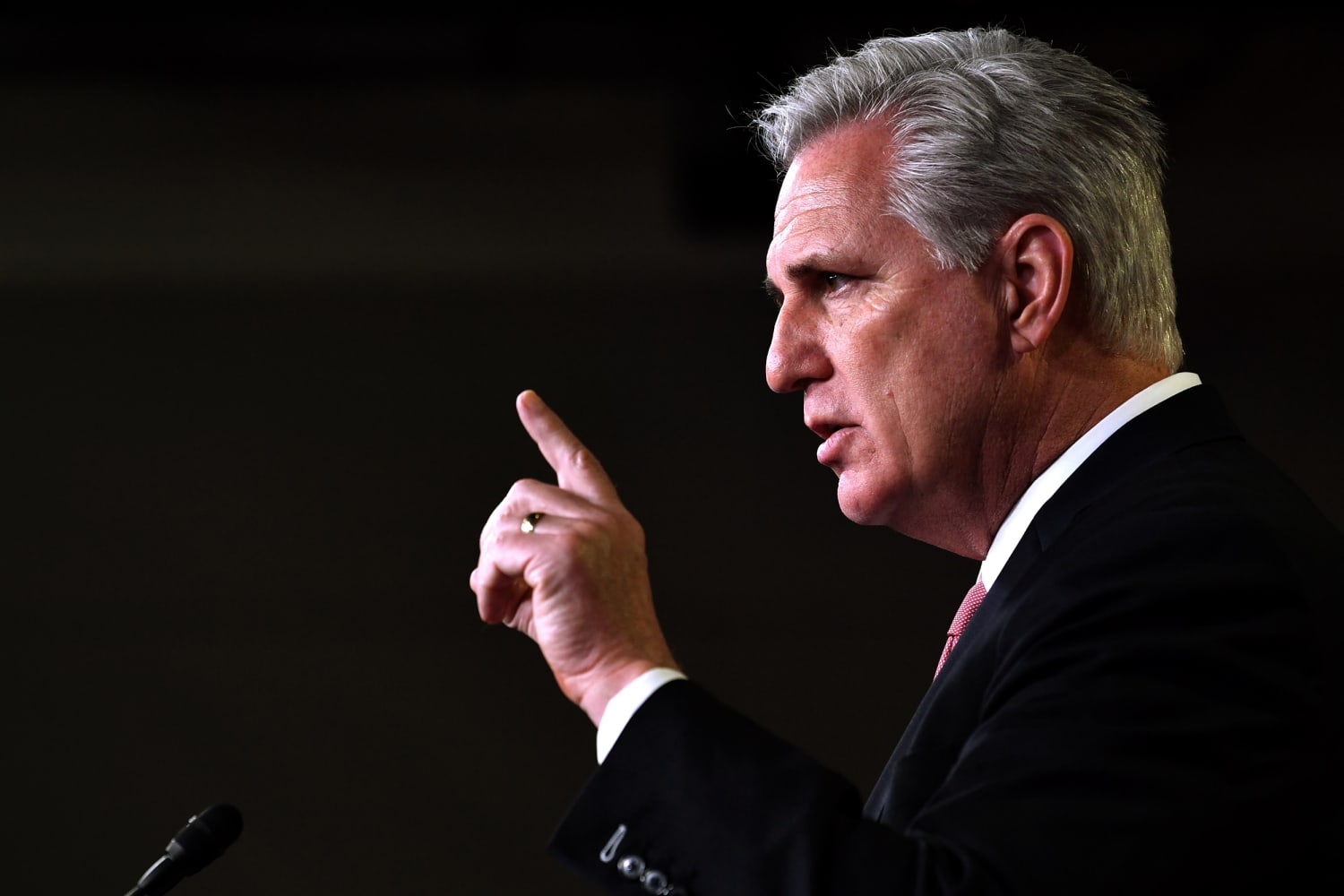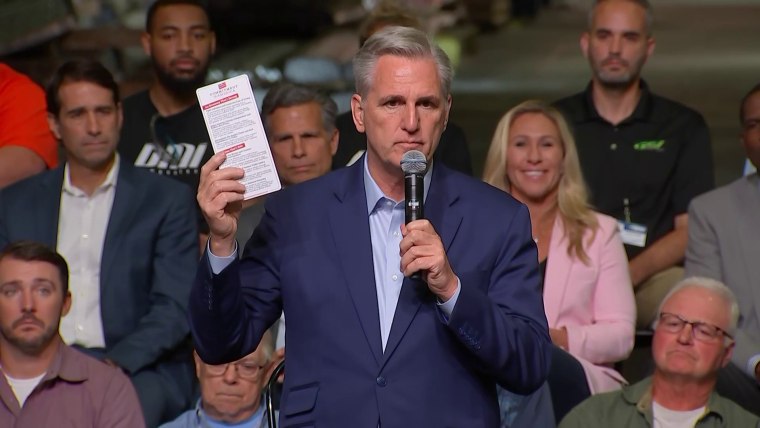House Republicans could see their most diverse conference in history sworn in in January. Their leaders, however, will be almost all white men.
If Republicans take control of the House in the midterm elections, the party’s top three leaders are guaranteed to be white males. In the next Congress, white men will also lead the House GOP campaign arm, the National Congressional Campaign Committee (NRCC), and occupy other lower-tier leadership spots.
Rep. Kevin McCarthy of California is not expected to face any opposition in his bid for House speaker, and neither is Steve Scalise of Louisiana for majority leader. Both are white. And three other white men — Reps. Tom Emmer of Minnesota, Jim Banks of Indiana and Drew Ferguson of Georgia — are all vying to be majority whip, the No. 3 leadership job.
The highest leadership post that Republican women or minorities have reached is chair of the GOP Conference — the No. 4 slot in the majority and No. 3 in the minority — which is currently held by Rep. Elise Stefanik of New York. She’s expected to remain the highest-ranking GOP woman in the whole of the next Congress as well, given that white men make up all but one member of the Senate GOP leadership team.
The composition of the incoming leadership team highlights a glaring challenge for House Republicans: Even as McCarthy and other leaders argue that the growing diversity of their candidates this year and the conference will help propel them to the majority, their leadership has consistently failed to reflect that diversity.
The likely reasons, according to some Republicans: White men still make up the overwhelming majority of the 212-member GOP Conference, and women and minorities haven’t yet built the type of broad coalitions needed to win some of the top leadership races as they’ve done in the Democratic Party.
“My assessment would be, they just haven’t had enough time to get their legs underneath them and deep enough to take on that type of role. So it’s a time issue, it’s not a quality issue. But it’s coming,” said one former GOP lawmaker who served with McCarthy, Scalise and Stefanik, and requested anonymity to speak about the challenges of his party.
“It’s figuring out how the institution runs, having the right allies downtown [on K Street], around the country and within the conference.”
In a statement, McCarthy spokesman Mark Bednar noted that members elect their own leadership team in a closed-door, internal election and that “Leader McCarthy fully anticipates our conference to elect a team that represents the ideas and values of the American people.”
But the demographics of the conference are beginning to shift, albeit slowly. Of the 16 minority House members elected in the 2020 election cycle, nine were Republicans, according to the Pew Research Center. That included the only two Black Republicans in the chamber, Reps. Byron Donalds of Florida and Burgess Owens of Utah; Hispanics like Reps. Carlos Giménez and Maria Elvira Salazar of Florida, Tony Gonzalez of Texas, and Mike Garcia of California; and two Korean Americans from California’s Orange County, Reps. Young Kim and Michelle Steel.
And with a diverse set of nominees on the ballot this November, House Republicans will almost certainly be adding more women and minorities to their ranks in 2023. Republicans have nominated 74 Hispanic, Black, Asian and Native Americans to run in the November midterms, including 33 Hispanic and 28 Black candidates, according to the NRCC.
Eighty GOP women are running for House seats in these midterms.
“One in 4 of the Republican nominees in NRCC-target races are women, just to underscore the point that House Republican women are going to build this majority and fire Nancy Pelosi,” Stefanik told reporters at a recent election briefing.
“I believe we will blow past 40” elected women “this cycle and we’re working towards 50.”
Stefanik said she got a wake-up call after the 2018 Democratic wave election left her party with just 13 GOP women in the House, including herself and Rep. Jackie Walorski of Indiana, who had been on the leadership track before she was killed in a car crash in August. Stefanik took action in the 2020 cycle and launched her E-PAC, through which she has compiled a national donor database and raised $4 million to date to help elect GOP women.
An ally of former President Donald Trump, Stefanik had considered seeking a promotion and running in the crowded GOP whip race this fall but opted to stay in her current post, which she took over in May 2021 after Rep. Liz Cheney, R-Wyo., was ousted from the job. Donalds has launched a long-shot bid to unseat Stefanik as conference chair, but she has the backing of the entire leadership apparatus and is the favorite.
For his part, Donalds, whom Trump once called a “rising star,” has not made diversity a central part of his campaign for conference chair. In a phone interview, he talked about having an “all-hands-on-deck” media strategy for the conference — local, regional and national — and said he “100%” believes it’s important for someone with a “principled” conservative view to have a seat at the leadership table. He’s a member of the far-right Freedom Caucus.
“In terms of members who run for office and get elected, the No. 1 thing is competency. Can you do the job, that’s No. 1. … If you want to talk about diversity, is that a good thing overall? Of course it is. Nobody’s going to say otherwise. But No. 1 is competence,” Donalds told NBC News. “And I think that if you were to ask the members, did they think I was competent enough to be the chief messenger of the conference, they would say yes.”
In addition to Stefanik, McCarthy’s leadership team is almost certain to add another woman: Rep. Kat Cammack, another freshman Florida Republican, and Rep. Lisa McClain of Michigan are both vying for GOP Conference secretary. Both are favorites of leadership, and at just 34, Cammack is also seen as a rising star in the conference.
But white men are expected to round out the rest of the elected leadership team. Rep. Mike Johnson of Louisiana is running unopposed for a second term as GOP Conference vice chairman, while Rep. Gary Palmer of Alabama is seeking another term as GOP policy chairman.
The heads of the three moderate and conservative ideological GOP caucuses are also expected to be white men. Rep. David Joyce of Ohio is chairman of the Republican Governance Group, the bloc of moderates formerly known as the Tuesday Group; Rep. Kevin Hern of Oklahoma is running unopposed to be the next chair of the conservative Republican Study Committee; and Rep. Scott Perry of Pennsylvania will stay on as chair of the ultra-conservative Freedom Caucus.
Stefanik and other leaders have argued that Republican women will occupy other top roles. If the GOP takes back the majority, Rep. Cathy McMorris Rodgers of Washington, a past conference chair, will become the first female chair of the influential Energy and Commerce Committee, while Rep. Kay Granger of Texas will become the first GOP woman to chair the powerful Appropriations Committee.
Freshman and sophomore women will also win subcommittee gavels, which can provide valuable experience and stepping stones for future leadership bids.
“I had a subcommittee gavel that allowed me to learn a lot as a sophomore a few cycles ago,” Stefanik said. “I will always be an advocate for our women to earn those leadership opportunities and I hope that they do run for leadership.”
Source: | This article originally belongs to Nbcnews.com










